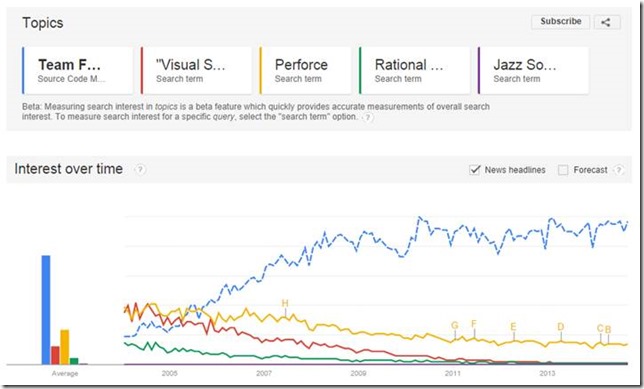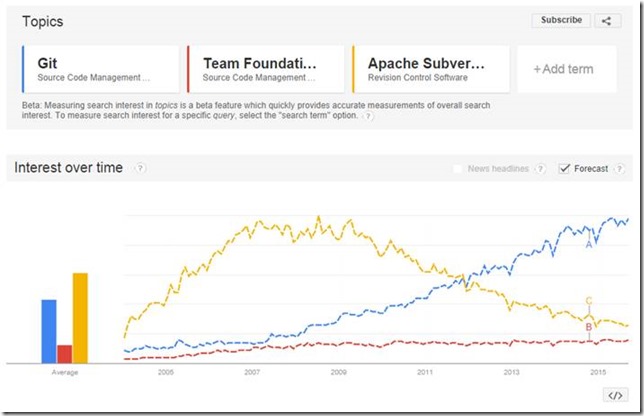Last month I went to a nice presentation at the Austin TFS User Group on migration from TFVC format to TFS Git, using Git-TFS, a very useful one, the kind that makes you want to research more after it.
However one of the first slides of the talk did a comparison using Google trends which was used as a justification to moving to Git, because according to it, TFVC was going nowhere, whereas Git was exploding in adoption (notice that the numbers are not absolute, that is they are normalized. For instance, if you have just TFS and Mercurial, the number for TFS will be different).
![clip_image001[6] clip_image001[6]](http://clearmindsoftware.com/image.axd?picture=clip_image001%5B6%5D_thumb.jpg)
I had in the had past previous encounters with skewed statistics, so I waited until the Q&A at the end to ask a few questions about it.
I pointed out that since we were seeing data that had been filtered through Google search, it did not take into account that most Microsoft tools users however would first go to the MSDN site first and search from there (or just press Help from Team Explorer), so some of the millions of people who have MSDN and use TFVC are not being represented.
Also, git has many client providers, such as Xcode to Tortoise-git. Most of them are also OSS with “best-efforts” support, meaning “if you have an issue, search in the Internet for a solution”. So in a way this trend curve also reflects a bit of where the information sources are for git related topics in general, it is a bit fragmented so you need to go through a search engine to have it all collected for research.
The most important data point I observed is that the TFVC curve (numbers aside) were pretty much stable. So “where is git interest growth coming from?” since the TFVC interest curve seemed pretty stable.
I recalled that around 2001 I had seen something similar about Linux adoption in the desktop: some pointed how it was growing so fast that it would overtake Windows soon. This growth curve was similar, steady but slightly rising for Windows, and steeper for Linux, showing it overtaking Windows in the forecast.
Time showed that the market shares were not changing that much, so where was the Linux growth coming from? Sun took too late to realize that it was their own Unix, Solaris (and for that matter, all of Unix variants) that were being cannibalized as people moved to Linux. Later Sun made Solaris into open source but it was already too late: most Unix users had converted to Linux.
If we could use “searches” as a proxy to “interest”, and that as a proxy for market share: with git growing and TFVC stable, what was the “Solaris” equivalent that was being replaced?
After I explained my point of view, the presenter went online and added Mercurial in the graph… there is surely a downwards trend on Mercurial queries, but that does not explain how git searches were growing:

I mentioned Subversion to him but we didn’t have time to try it out so I continued from home.
I then added Subversion, listed under “Apache Subversion Revision Control System” to the graph, and voilá, the puzzle was solved: the new trend graph, confirmed that the open source community (and for that matter, Microsoft TFS users as well) is readjusting its preferences. Git is now as popular as Subversion was in the 2007-2009 time frame. The growth of interest in git is pretty much explained by the winding down of searches on Subversion and Mercurial, and probably some from TFVC now migrated to TFS git:

I then continued my research looking for the development of Interest in other source control systems, starting by the all-time grandfather of many, CVS. Back-extrapolating its curve, you can see that it was very popular, but was itself run over by Subversion in the 2005 time frame:

I then tried out with others: Rational ClearCase, Rational Jazz Source Control, Perforce. Out of these, only Perforce showed a small but steady curve. ClearCase is now reduced to just a trickle, and Jazz Source Control did not even show up. Finally I had to see if any record of Visual Source Safe still existed after 2005, and as expected it dwindled after 2005:

As a final experiment I tried the “Forecast” feature which seems to trace a simple extrapolation based on the data so far (forecast starts at ABC points below). The extrapolation confirmed the steadiness of the TFVC curve so far, and the ongoing dwindling of Subversion as it gets overtaken by git as all other open source version control systems:

So in conclusion:
- Git will become to open source version control systems what Linux is to open source Unix-like systems;
- TFVC will remain stable for the foreseeable future, with users of TFS-git adding to the number of git adopters;
and
- You can use statistics to justify any point of view, so be on the lookout for any inadvertently skewed perspectives;
- Do not just accept the data, think about it too – logic will help you in finding the hidden aspects (the “Solaris”) of the question;
If you have read so far and have a different perspective, please let me know what your thoughts are on this.